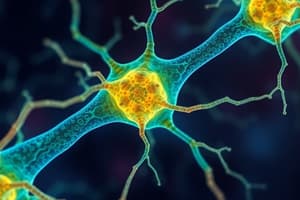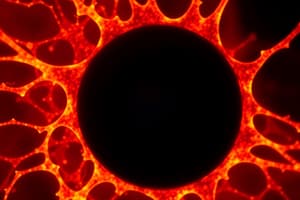Podcast
Questions and Answers
Which molecule is responsible for stimulating the opening of sodium channels in photoreceptor cells?
Which molecule is responsible for stimulating the opening of sodium channels in photoreceptor cells?
- cAMP
- cGMP (correct)
- cGTP
- cAMP
What enzyme produces cGMP in the photoreceptor?
What enzyme produces cGMP in the photoreceptor?
- Protein kinase
- Adenylyl cyclase
- Phosphodiesterase
- Guanylyl cyclase (correct)
What happens to the membrane potential of photoreceptor cells when cGMP is reduced?
What happens to the membrane potential of photoreceptor cells when cGMP is reduced?
- It becomes more positive
- It fluctuates
- It remains unchanged
- It becomes more negative (correct)
What is the pigment in rods called?
What is the pigment in rods called?
What is the receptor protein in rods called?
What is the receptor protein in rods called?
What is the prebound agonist in rods called?
What is the prebound agonist in rods called?
What is the G-protein called that is stimulated by the bleaching of rhodopsin?
What is the G-protein called that is stimulated by the bleaching of rhodopsin?
What is the effector enzyme activated by transducin?
What is the effector enzyme activated by transducin?
What does PDE activity do to the cGMP level?
What does PDE activity do to the cGMP level?
What happens to the sodium channels when the cGMP level is reduced?
What happens to the sodium channels when the cGMP level is reduced?
Which of the following is true about phototransduction in rods?
Which of the following is true about phototransduction in rods?
What is the role of G-proteins in phototransduction?
What is the role of G-proteins in phototransduction?
What happens when the photopigment in a rod is activated by light?
What happens when the photopigment in a rod is activated by light?
What is the depolarization of the rod outer segment in complete darkness caused by?
What is the depolarization of the rod outer segment in complete darkness caused by?
What is the membrane potential of a typical neuron at rest?
What is the membrane potential of a typical neuron at rest?
What is the membrane potential of the rod outer segment in complete darkness?
What is the membrane potential of the rod outer segment in complete darkness?
What is the movement of positive charge across the membrane in the dark called?
What is the movement of positive charge across the membrane in the dark called?
What is the equilibrium potential for K?
What is the equilibrium potential for K?
What is the process by which chemical signals are transduced into electrical signals during synaptic transmission called?
What is the process by which chemical signals are transduced into electrical signals during synaptic transmission called?
What is the process by which the absorption of light energy is transduced into a change in the photoreceptor membrane potential called?
What is the process by which the absorption of light energy is transduced into a change in the photoreceptor membrane potential called?
Flashcards are hidden until you start studying
Study Notes
Photoreceptor Cell Signaling
- cGMP is the molecule responsible for stimulating the opening of sodium channels in photoreceptor cells.
- Guanylyl cyclase produces cyclic GMP (cGMP) in photoreceptor cells.
- When cGMP is reduced, the membrane potential of photoreceptor cells hyperpolarizes.
- The pigment in rods is called rhodopsin.
- Rhodopsin is the receptor protein in rods.
- Retinal is the prebound agonist in rods.
- Transducin is the G-protein stimulated by the bleaching of rhodopsin.
- Phosphodiesterase (PDE) is the effector enzyme activated by transducin.
- PDE activity reduces the cGMP level.
- When the cGMP level is reduced, the sodium channels close.
- Phototransduction in rods is a cascade of events that begins with the absorption of light by rhodopsin and ends with the closure of sodium channels.
- G-proteins act as molecular switches in phototransduction.
- When the photopigment in a rod is activated by light, it triggers a cascade of events that leads to the closure of sodium channels and hyperpolarization of the cell.
- The depolarization of the rod outer segment in complete darkness is caused by the influx of sodium ions through cGMP-gated channels.
- The membrane potential of a typical neuron at rest is -70 mV.
- The membrane potential of the rod outer segment in complete darkness is ~-40mV.
- The movement of positive charge across the membrane in the dark is called the dark current.
- The equilibrium potential for K is -90 mV.
- The process by which chemical signals are transduced into electrical signals during synaptic transmission is called synaptic transmission.
- The process by which the absorption of light energy is transduced into a change in the photoreceptor membrane potential is called phototransduction.
Studying That Suits You
Use AI to generate personalized quizzes and flashcards to suit your learning preferences.




